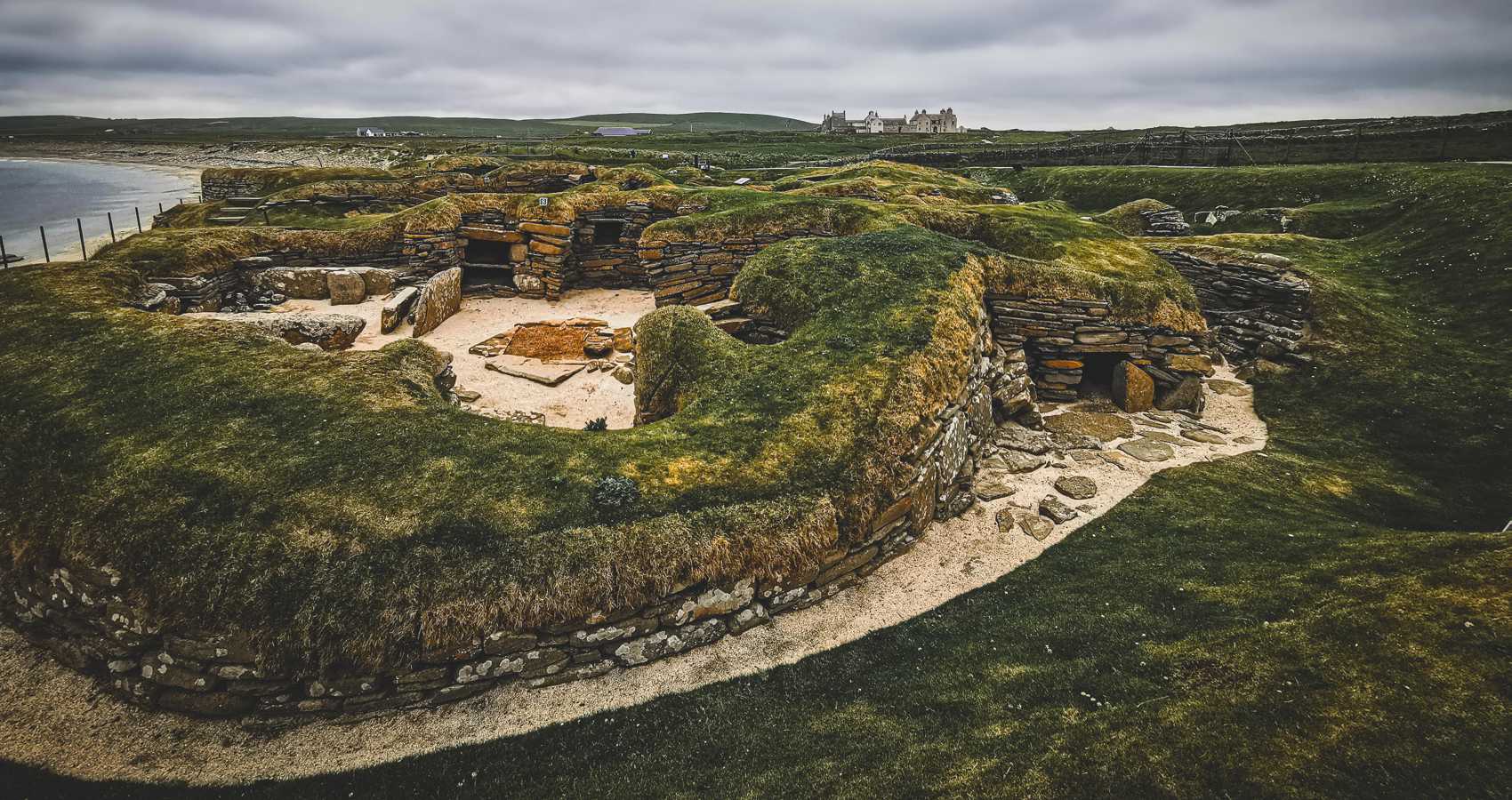A Bloody Path
The Colonization of Scotland
written by: Lasara Firefox Allen
@firefoxallen
 I start my day with DuoLingo lessons in Scottish Gaelic. At this time just over 1% of Scottish people speak the language. I am learning this language as a way to understand my people. I see this is part of my ancestor work. I make an offering of my time, of intention. I make an offering for wholeness.
I start my day with DuoLingo lessons in Scottish Gaelic. At this time just over 1% of Scottish people speak the language. I am learning this language as a way to understand my people. I see this is part of my ancestor work. I make an offering of my time, of intention. I make an offering for wholeness.
***
4000 years ago my people were stacking rocks into artful funerary cairns miles from where I now sit. 4000 years ago my ancestors walked the earth here in Scotland and lived a life we know little to nothing about.
Seeking for my roots, I look into what historians have to say about my Indigenous forebears. Mostly it’s that the ancient ones of my lineage, known as the Caledonii, and then the Picts (even though this is a name given them by the Romans, meaning “painted people”), and their ways of life, are “shrouded in mystery.”
Also. Before the Picts, before the Caledonii. Before these ancient ones there were people who are even less known, even more elusive as far as remnants of evidence to their existence go.
Except Skara Brae. Skara Brae is proof they lived. Before even the impressive and ancient pyramids of Giza stood, Skara Brae was a thriving village with ways of life that the place tells stories about.
Discovered in 1850, Skara Brae only became an UNESCO protected site in 1999. While many items that were not too heavy to move were likely sacked over the decades, thankfully much of the site is built of huge slabs of stone so they are still in place. And, in more recent archeological excavations, finds have included carved stone objects which may have had spiritual or religious significance, gaming dice, tools, pottery, and jewelry including necklaces, pendants, beads, and pins.
An earth-structure village, the homes at Skara Brae, and one building that was some kind of communal space, are built into the midden (refuse pile) of a presumed even earlier village. The walls and roofs are built of driftwood, whale bones, and stone slabs. Once constructed the buildings were then covered in soil for insulation. The buildings were linked by covered passageways against the cold of winter. Impressively, Skara Brae boasts what seems to have been the oldest known indoor plumbing; in addition to the hallways, a network of underground sewer lines links the buildings.
The people of Skara Brae survived on farming, hunting, and fishing. The settlement seems to have been a peaceful place; it would not have been easily defended, and no weapons have been found on the site.
It is still unclear why Skara Brae was abandoned. But it was, and then was covered by sand over the course of a couple decades. That sand preserved the village for thousands of years until a storm uncovered it in the 1800s. Because of the level of protection afforded by the sand covering, Skara Brae is sometimes called the Pompeii of Scotland.
***
History is written by the victor. By the conqueror. By the colonizer. There are shreds left behind by those conquered. Even those who care to find truth regarding their stories find little to go on. History is written from the frontlines of the battlefield. From the banks of the river. By the victorious.
The history left behind by the conquered is hidden. Occult. Threaded into mundane patterns — the weave of cloth, a recipe for a native food, symbols etched into handiwork. The history of the conquered is whispered under the breath, shared in folktales, stitched into patterns.
Keys for translation are sometimes lost along the way.
***
Together my grown daughter and I trace the few known steps left behind. We drive out an unmarked, single track road to find our way to the oldest standing stones and cairns in the region. (Shy of heading all the way up to Orkney, which will not happen for us this trip. It’s November and the northern weather is too much for me to face. Having driven up to Inverness from Edinburgh buffeted by an impressive storm, my driving skills have already been tested.)
We pull into a barely-marked parking area. We see the standing stones and rock piles in the distance. Awe descends.
Clava Cairns has a hush over it, a stately, strong aura of gravitas.
It is different from the US here in Scotland with historical sites: many are open and you can touch them, stand in them, walk around them, commune with them, feel them, experience them. And experience them we did.
***
The interesting and upsetting thing about colonization is that it not only obliterates whole peoples and ways of life, it erases them. Languages erased. Thoughtforms erased. Lives erased. Proof of a different narrative, erased.
Historians, archeologists, and anthropologists are limited by the frames set in place by the dominant cultural narrative. We cannot see what we cannot perceive. We cannot know what we are missing.
***
In the experiencing of the place pieces of self come to rest: some form of automatic, naturally occurring soul retrieval. My body shifts into remembering. The stones have called us home, and now the stones are calling us home again, parts joining to parts in the aether of the soul.
Tears come for both my daughter and I, touching the stones raised by the hands of our ancient ones. We cry in recognition, in awe, in remembrance. My body grounds into the experience of being held by my lineage. DNA realigned and integrated, awakened to ancient memory, we walk away knowing ourselves more than we did before.
Even if the original language our people spoke is lost, like tears to rain. There is no finding it again.
***
The saddest thing about lost languages is the loss of identity and worldview that comes along with the eradication of words and sounds, containers for ideas. Words have the power to create. And as words are lost, the power to create the things held and shaped by the words is lost too.
What would my ancestors tell me now, I wonder, if our original language had survived.
***
First an ancient peoples with little known or understood legacy beyond the cairns and villages currently under examination. Then the Caledonii. Then the Picts.
The Picts fought ferociously and held Rome at bay. Rome never succeeded in the conquest of Alba, Caledonia, Scotland, whatever the land was called by its inhabitants then. Rome had Hadrian’s wall erected to keep the Scots on the far side of the wall. (The original “Build a wall,” joked a historian who specializes in the fall of Rome whom we met in Edinburgh.)
Then the Gaels, known to the Romans as the Scotii. The Picts, by many accounts, were subsumed by the Gaels somehow. The Pictish language and ways just…ceased to exist. But, 1 out of 10 Scottish men were proven to have Pictish DNA in a recent study.
But even that is an oversimplification. According to many historians, ancient Scotland is considered to have been a melting pot of ideas and languages and cultures; Picts and Gaels and Vikings and Anglo-Saxons, all coexisting, in war and sometimes in peace.
Seemingly, most times the peace was a compact cemented and inspired by self-defense. Under one banner, the Scots fought the English for centuries.
The English were relentless, and finally prevailed. Fast forward to a unified Scotland, and a vanquishing England. At this point, there was one crown that ruled all of the Island of Britannia.
However, who wore that crown was still up for debate.
***
Prior to the Cairns we visit Culloden Battlefield. We hear the story of the eradication of the Highlands and Islands way of life in 1746 that came in the aftermath of the Jacobite Uprisings. We hear the stories of generations of men, families, fighting side by side, thirteen years of age to 77. Slaughtered.
After hundreds of years of the Scots fighting the English off, the battle of Culloden lasted under an hour. In that time over 1200 Jacobites, supporters of the Catholic claim on the crown, were slain. The Highlanders were ruthlessly cut down by the Duke of Cumberland’s men, the redcoats.
Our guide, an amazing storyteller named Valerie, tells us of the suppression of the Gaelic language (which by the accounts of the oppressors had already nearly died out). The banning of the wearing of Highland dress. Language, way of life, cultural dress, all suppressed at risk of punishment, and even death. We hear about a young man who drowned trying to out-swim the redcoats in his full Highland regalia. We hear about families burned out of their homes, starved, raped and murdered.
The Duke of Cumberland gained the nickname of The Butcher in the ensuing carnage.
***
We are all colonized. Culture after culture falls under the tyranny of the oppressor. This instance of colonization of Scotland by the English happened under 300 years ago on the battlefield of Culloden. (The English, who were busy colonizing the rest of the world at the time too.) At this site, the Highlander and Islander way of life was dealt a fatal blow. England did its best to beat the Scottish identity out of Scotland and the Scottish people.
***
In 2014 a Scottish referendum for political independence was voted on by the Scottish people. With 55% of Scots voting no, it failed to pass. In exit polls, voters surveyed who voted no cited a desire to retain the British Pound as the main reason for staying in the UK. Those who voted for a return to independence cited disillusionment with the politics of Britain as the main decision point.
While the UK is attempting to block it, there is another Scottish referendum in the works. The referendum has been ruled as not allowed by the Supreme Court of the UK, but this ruling is having the effect of incensing the desire for freedom amongst pro-independence Scots.
While some Scots I spoke with are still afraid of losing the financial backing of the British government, many are hopeful for an opportunity to reclaim Scottish independence and the possibility of rejoining the European Union if the referendum passes. (62% of Scottish voters voted against Brexit.)
Today, as the supreme court decision lands, many pro-independence Scots are preparing to take to the streets.
***
There is an active resurgence of Scottish identity and ways happening currently — as there has been ongoingly.
And still, during my time in Scotland I did not meet one person who was fluent in Scottish Gaelic. I continue spending my mornings forming the words of my ancestors and learning about the ways of my people.
Next time I return to the land of my ancestors I will find members of that 1% of fluent folk, and try my tongue at conversation.
***
In the early hours of the morning I make a prayer. Saor Alba. Am faigh sinn iomlanachd. May Scotland find its way back to freedom. May we find wholeness.
May all people recover from colonization. There is no going back, only forward; may we make offerings to reinvigorate the ways of our people. May we remember how to form the words our worlds were built by. May we find our way back to our own cultures, our own cultural identities.
With the strength of my ancestors behind me and in solidarity with my Scottish kin I continue speaking into wholeness the stories of my ancient ones.
- A Bloody Path: The Colonization of Scotland - April 16, 2023



